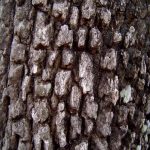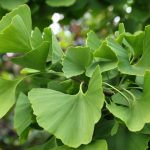TREE LIFE
NOVEMBER 2017
MASHONALAND CALENDAR
Saturday November 4th: Botanic Gardens walk. There is still a lot flowering and perhaps some rain by then. Come and enjoy a lovely hour and a half walk in this beautiful garden. Meet at 8:30am.
Sunday November 19th: Outing to Rain Tree in Umwinsidale: plenty to see at a superb venue. Meet at Rain Tree Venue at 10.30. Bring a picnic, chair, hat etc.
Saturday November 28th: Visit to Katrin and Steve Gamble’s lovely garden in Kent Road, Highlands. Members will remember our visit there in January this year. Meet at 2:30 pm
CHRISTMAS PARTY 10th December 2017
It’s got to that time of year again when we begin to think of a Christmas gathering, but a few things are different this year. Our “almost” tradition of fun and games at Val d’Or is not going to happen as our lovely hosts Bill and Fiona will be away. So we have had to think of new ideas.
The general feeling was that a “bring and share” lunch at the Rondavel at the Mukuvisi Woodlands would be a good place to get together to embark on the Christmas Season and mark the end of a successful year for the Society. There are shady trees if it is sunny, cover if it rains and generally a pleasant enough venue which is easily accessible
The proposed plan is that we should meet at the Rondavel for tea/coffee Christmas fare at 10.30 on 10th December. At about 11:00 am there will be a Powerpoint presentation about the “Moosh in da Boosh” event held recently at the Lasting Impressions camp site below Claw Dam just beyond Kadoma. This will be followed by a “Chinese Auction”! Don’t gasp. Every member attending is asked to bring a small gift, certainly of not more value than $10, suitably wrapped to be placed under the Christmas Tree. Each member will then draw a number which will give them their place in the queue to choose their gift. More details at the time. In this day and age where many of us do not want to accumulate “things” any more, may I suggest that the gift should revolve around ideas “for the pantry shelf” or “for the bar fridge”. Thanks to Adele who will test our brains with the traditional quiz!
This activity will be followed by a “bring and share” lunch which we will be able to lay out on tables in the Rondavel. As there are no facilities for crockery and cutlery at the Rondavel, please bring your own “mess bag” containing plates, cutlery and glasses and, of course, your cooler bag with your favourite tipple. The Society will provide the usual boxed wine for the meal. After which, it will be time for your Sunday afternoon nap or take time down at the water hole watching the game.
Please set aside this date to enjoy a day of good camaraderie and we hope some fun.
-Mary lovemore
HOW FAST DO TREES GROW?
Dave Rockingham-Gill moved into No 4 Fernleigh Road in Vainona just over 41 years ago and whilst living there he planted many trees. Some were commemorative trees which became known as “Alice”, “Jane” or Olivia” or some other name to celebrate an event e.g. University graduation or a special birthday. Sadly, he sold his home to a property developer who was going to clear the plot of all trees and buildings and replace the same with many cluster homes.
Common sense tells us that the rate a tree grows depends on a few factors – temperature, rainfall, type of soil, etc. and of course the species of tree. There’s not much point in trying to grow a tree in the tropics that is native to some location in the Arctic Circle – although it could be interesting!
Using seeds from the Mukuvisi, Dave planted a Msasa 40 years ago and although partly in the shade of a large fig tree (Ficus microcarpa??), this tree is now 18 metres tall. Dave also planted six Msasa trees fairly close together and after some 10 years found that the trees in the shade were only one metre high while those in the sun were four metres high. He also had two Baobab trees, one 20 years old and an older one aged between 35 -40 years. Although both were in shady areas, the younger one was about 3 metres tall whilst the older one in the chicken run was 5 metres tall. He thinks the splashing of water and the chicken manure was good for this tree. He also planted a Faidherbia albida (Anaboem) which after 5 years was only 1 metre high. When twenty years old, the same tree was some 12 metres tall and it first fruited when it was 17 years old.
A row of Ligustrum lucidum (Glossy Privet) were no longer trimmed as a hedge and after 40 years they had grown to 20 metres tall and killed all the neighbouring Bottle Brushes. Of interest is an unknown four-year-old Acacia which was only 30cm high. Dave also had a Persea americana (Avocado Pear) which was 20 years old and some 15m tall but had never produced any fruit even after hurting it!
Some other trees on the property – trees marked 41+ – were there when Dave moved in:[/vc_column_text]
| Species | Age (yrs) | Height (m) |
|---|---|---|
| Albizia gummifera (Smooth-bark flat-crown) | 16 | 12 |
| Caesalpinia ferrea (Leopard tree) | 16 | 19 |
| Caryota mitis (Fish-tail palm) | 14 | 6 |
| Citharexylum spinosum (Lady Chancellor (female)) | 30 | 10 |
| Citharexylum spinosum (Lady Chancellor (male)) | 15 | 5 |
| Cordia africana (Large-leaved Saucerberry) | 41+ | 17 |
| Croton megalocarpus (East African Croton) | 15 | 4 |
| Delonix regia (Flamboyant) | 41+ | 17 |
| Erythrina lysistemon (Sacred Coral Tree) | 16 | 17 |
| Erythrina lysistemon (Sacred Coral Tree) | 41+ | 8 |
| Ficus microcarpa? (Fig species) | 40 | 24 |
| Ficus sycomorus (Sycamore fig) | 30 | 10 |
| Hamelia patens (Fire Bush) | 16 | 6** |
| Jacaranda mimosifolia (Jacaranda) | 20 | 22 |
| Jacaranda mimosifolia (Jacaranda) | 30 | 22 |
| Khaya anthotheca (Red Mahogany) | 30 | 19 |
| Morus alba (Mulberry) | 25 | 7 |
| Parkinsonia aculeata (Jerusalem Thorn) | 15 | 3 |
| Prunus cerasoides (Flowering Cherry) | 16 | 9 |
| Psidium guajava (Guava) | 41+ | 5 |
| Punica granatum (Pomegranite) | 41+ | 4 |
| Rauvolfia caffra (Quinine tree) | 41+ | 22 |
| Searsia lancea (Willow crowberry) | 41+ | 8 |
| Spathodea campanulata (African Flame Tree) | 41+ | 18 |
| Syagrus romanzoffiana (Queen Palm) | 34 | 18 |
| Syzygium paniculatum (Brush Cherry) | 40 | 5 (in shade) |
| ** White-bellied sunbirds like this tree | ||
| Species | Age (yrs) | Ht (m) |
| Tabebuia chrysotricha (Golden Trumpet) | 14 | 5 |
| Thevetia peruviana (Yellow Oleander) | 40 | 6 |
| Acacia abyssinica (Nyanga Flat-top) | 16 | 18 |
| Acacia abyssinica (Nyanga Flat-top) | 16 | 20 (in shade) |
| Acacia abyssinica (Nyanga Flat-top) | 16 | 9 |
| Acacia xanthophloea ((Fever Tree) | 12 | 9 |
| Acacia xanthophloea (Fever Tree) | 4 | 7 |
–Tony Alegria
SOME TREES AT 10 SIMS RD, HARARE
We have over 110 species of trees and shrubs on our one-acre plot in Mount Pleasant, so I’ll just select a few which may be of interest.
There are four Acacias in our garden, namely A. burkei, A. gerrardii, A, nigrescens and A. xanthophloea. The first has grown well and is now quite tall (± 8m); it has wickedly hooked thorns in pairs and might be mistaken for a Knobthorn except that its pinnae and pinnules are a little smaller (more like A. goetzei). Its common English name is Black Monkey Thorn (don’t ask me why!), Zim. No. 193, Shangaan name mukaya. The A. nigrescens (Knobthorn, Zim. No. 215) has stuck at less than a metre high for several years but has finally started to grow upwards, now standing at about 3m. I believe it has the largest pinnules and smallest number of pinnae of any Acacia species. According to my late schoolfriend L J Mullin, it has numerous vernacular names, one of the basic Shona ones being chinanga, but also mukaya (same as A. burkei), siNdebele katopa; the word ‘nigrescens’ means ‘tending to be black’ in Latin.
The A. gerrardii, Grey-haired Acacia, Zim. No. 203, named for the velvety covering of the young twigs, has finely pinnate leaves (bi-pinnate of course like all Acacias) and straight thorns and will therefore have globose blossoms. Our specimen is struggling somewhat beneath a tall Millettia grandis and Anthocleista grandiflora in the front garden; Shangaan name sesani, siNdebele ikope. Most successful of the four has been the A. xanthophloea, despite being normally a low-altitude species (indeed there are many fine examples planted around Harare), which looks to be at least 12m high and is topping both a big Trichilia dregeana and a fairly tall and lovely white flowered evergreen Craibia (zimmermannii (?). The specific name ‘xanthophloea‘, coming as it does from the Greek words xanthos (ξανθος) – yellow – and phloios (φλοιος) – bark – is a nicely descriptive name for the Fever Tree, Zim. No. 228, with its conspicuous flaky yellowish-green trunk and branches. Its thorns are straight and flowers bright yellow globes. The Shangaan name is njelenga.
The above four trees belong to the sub-family mimosoideae within the main family FABACEAE (or LEGUMINOSAE, which is the older name that I prefer as it is more meaningful, clearly referring to the pea or pod-bearing family), and all are of course indigenous to Zimbabwe.
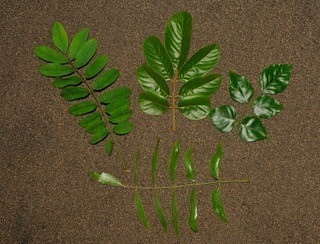
Leaves of Millettia spp.
In the Sub-family Papilionoidae (also under LEGUMINOSAE) we have 3 non-indigenous species of another genus: Millettia: M. grandis, M. mossambicensis and M. pinnata. All three have imparipinnate leaves, those of M. grandis being the most ‘feathery’, with up to nine pairs of opposite leaflets + one terminal. There has been some doubt as to the true identity of my M. mossambicensis but its young leaves in particular, with slightly hairy surface & rachis, as well as its mauvy-blue pea-type flowers, appear to accurately match the description in Trees of Southern Africa (Coates Palgrave 2002). It is endemic to central Mozambique, while M. grandis occurs only along the coast of Kwazulu-Natal & the eastern Cape where it is known as Umzimbeet. Millettia pinnata, formerly Pongamia pinnata, comes from Asia & Australia where it is called Indian Beech or Pongam Oil Tree and may grow to 25m, though mine is just a large bush.
Closely related to the three foreigners above is one of my favourite indigenous trees, Bolusanthus speciosus, the Tree Wisteria, Zim. No. 287, of which we have a good specimen just in front of the house.
-Dave Hartung
BOTANIC GARDEN WALK 7th October 2017
The morning was cloudy, cool and windy, but several members turned up to enjoy a very informative and interesting morning looking at trees in flower. This included a good number at this time of the year. The group led by Tony included Meg, Mary, David, Teig, Jan, Sarah, Richard, Helen who brought Wanling, Barbara, Solomon, Bilal and Ann.
We set off towards the Lowveld section of the Gardens, stopping first at a handsome flowering gum, Eucalyptus torelliana, with white flowers, green branches and a distinctive fruit of small rounded woody balls.
The Marula (Sclerocarya birrea) was in full flower, with male flowers found in unbranched sprays. This species is dioecious, with separate sexes on different trees. They are deciduous early, standing bare for many months.
The wild mango, Cordyla africana, was spectacular with bright yellow flowers. The yellow is provided by the stamens up to 2.5 cms long, petals are absent. The calyx is green and holds liquid nectar. The fruit is a fleshy drupe, edible and high in vitamin C. This is a large spreading tree occurring at low altitudes.
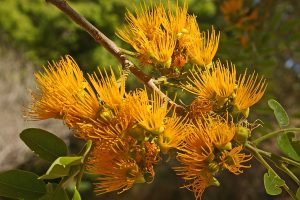
Cordyla africana. Photo: Meg Coates Palgrave
Acacia nigrescens, commonly called the Knobthorn, with its trunk covered in large knobs, was in full flower – white catkins and hooked thorns. The flowers appear before the leaves, making it very conspicuous.
Acacia galpinii, is a large tree occurring in open grassland. Flowers are white spikes, the buds are first purple and spectacular and when open they are pale yellow spikes. The tree has hooked prickles, occurring in pairs just below the nodes. This started a discussion of the differences between a prickle and a thorn. A prickle is a sharp outgrowth from the bark or epidermis and can be snapped off without tearing the wood. A spine or thorn is a sharp pointed structure, an outgrowth of the woody tissue, usually with buds on its side. Acacia species either have prickles or true spines.
Acacia erioloba, the Camel thorn, has flowers which are yellow balls, paired spikes, very thick pods and its bark is blackish rough and fissured. It occurs in Kalahari Sand.
Baphia massaiensis is another Kalahari Sand tree. After a good rainy season the white flowers are prolific. Just a few flowers had opened when we were there but the tree was covered in buds and in the next week would be a site to behold. The pods are distinctive and very pointed. The tree is a legume, with alternative, obovate greyish-green leaves that have prominent lateral veins. The new leaves are velvety with a notch at the top of the leaf.
Combretum zeyheri bears flowers in large spikes, with the male stamens prominent. It has a large four-winged fruit. Another small tree, the mouse-eared Combretum – Combretum hereroense – was covered in pale flower spikes.
By the path was the herbaceous shrub Plumbago zeylanica, from the Lowveld with its striking white flowers, and next to it was a handsome Ficus sp. that bore masses of small round figs. The flowers of the fig are inside the fruit, the receptacle forming the fleshy exterior.
The Lannea discolor that we saw was a male tree in flower. The ripe fruit from the female tree has a taste similar to grapes. Then we came across three Bolusanthus speciosus, small to medium trees with a very rough, black fissured bark. The flowers are spectacular but were almost over, the pods from last year still on the tree.
Near the Herbarium is the pink Tabebuia heterophylla, with palmate leaves. Across the way another pink Tabebuia, but of another species, had darker leaves and the flowers were different, large and beautiful.
Back down the road is a small- leaved Bauhinia grandidieri. The leaves are bifoliolate, the flowers pink with a small brown pod. And a rather spectacular climbing Combretum microphyllum or C. paniculatum with a profusion of bright red flowers. We also came across a flowering Strophanthus sp. (probably S. speciosus) with unusual flowers – a maroon corolla tube with long wavy yellow petals – and a Rothmannia manganjae with masses of flowers and green fruit. This tree is a member of the RUBIACEAE family. On the way out we found a Millettia grandis from South Africa in spectacular flower, a paler mauve than the Jacaranda, with large rusty pods. Then a Craibia affinis covered in white pea flowers, with pinnate leaves and a swollen petiole.
Our final tree was a Hymenaea verrucosa (ex Trachylobium verrucosa) with a profusion of mauve flowers on the top of the tree.
Thank you for a very good walk.
-Ann Sinclair
Moosh in da Boosh 13-16 October 2017
On ‘lucky’ Friday 13th October, about fifty members of the Bird, Tree and Astronomy Societies met at Lasting Impressions, near Claw Dam outside Kadoma, to enjoy a social and educational weekend in the bush. Some people camped in the very attractive camp sites on green lawns under shady trees. Others stayed in the thatched ‘A’ frame type dormitories. Meg and I had booked a ‘cottage’. This turned out to be a house on the banks of the beautiful Msweswe River next door to Alistair and Shelley’s Croudace’s house. I say ‘cottage’ but the building had four bedrooms, two bathrooms and seventeen beds!
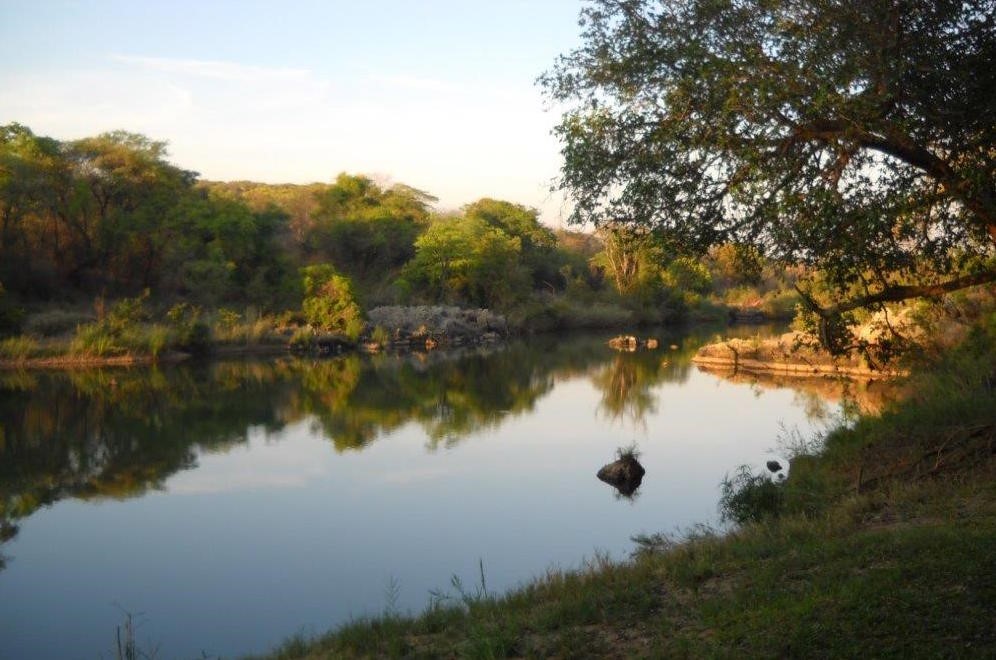
Msweswe River
One morning Meg and I were looking at trees along the river bank when we heard a loud rumbling sound and a rock came tumbling down the hill behind the house. We discovered there was a team of workers prising rocks loose and rolling them down the hillside. Alistair explained that the river bank had been badly eroded and he was going to shore it up with rocks and backfill it with sand especially around the rather splendid Ficus sycomorus which was growing right on the bank and had developed amazingly long roots to cope with the disappearing bank.
Alistair was a most attentive and pleasant host and nothing was too much trouble to make our stay enjoyable and comfortable. Shelley was away in America so we did not get to meet her.
Tony had organised a full and varied programme and there was something for everyone. The large dining area was the hub of activity. We had all our meals there – nothing fancy but tasty, well-cooked food served by happy and willing staff. There was a system of three basins of water where we each did our own washing up. It caused some amusement but worked well.
Presentations took place in the same area and we had excellent talks on:
- BirdLife Zimbabwe Bird Presentation by Ken Dixon.
- Introduction to Tree Identification and Introduction to Astronomy by Tony Alegria.
- Rocks and Geology by Percy Hastings (a geologist from Bulawayo) – talk and walk.
- A hands-on demonstration of The Scale of the Solar System by Simon van der Linden.
- The Celestial Sphere by Francis Podmore using many models.
- The Pattern of Life, featuring, among other things, the life cycle of butterflies. This was a fascinating film made by Meg Coates-Palgrave and her husband about 50 years ago and recently put onto DVD.
- Chameleons by Rob Jarvis
- Trip to Northern Zambia to see the shoebills – Tony Alegria
Outdoor activities included:
- Bird walks in the early mornings and late afternoons.
- Tree walks.
- After dinner trips to the dam wall where a telescope was set up to view and learn about the night sky. Laser beams were used to point out items of interest in the heavens.
- An evening at Alistair’s house where we met a three-legged and very agile bush baby (it had got a leg caught in a trap and had chewed through its leg to get free), a beautiful young rescued civet and an egg-eating snake. The egg-eater would normally swallow an egg whole, crush the egg so that the contents went into its stomach and then spit out the neatly crushed and folded shell. Alistair improvised by putting the contents of an egg into a small plastic bag which the snake treated as an egg!
- Swimming in the very inviting pool built among the rocks (the weather was very warm).
- Boat trips on the dam organised by local residents so that we could look at water birds.
We went up to the highest point on the property, nicknamed Mount Everest, from where we had a magnificent view over the woodland and dam. There was a rocky outcrop up there with an interesting Ficus abutilifolia growing on it.
Jan had particularly wanted to see a Margaritaria discoidea and on the last afternoon Meg identified one growing right outside the building where Jan was sleeping!
Late each afternoon we were all drawn to the western side of the building where we could sit and have a drink and watch the sun set and wait for the evening coolness.
All in all it was a very enjoyable week-end and it was indeed very ‘Moosh in da Boosh’!
Dawn Siemers
TONY ALEGRIA


